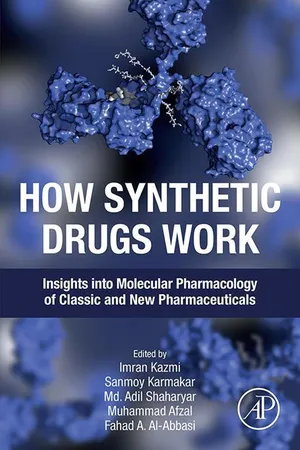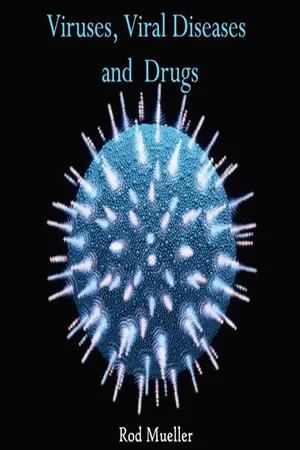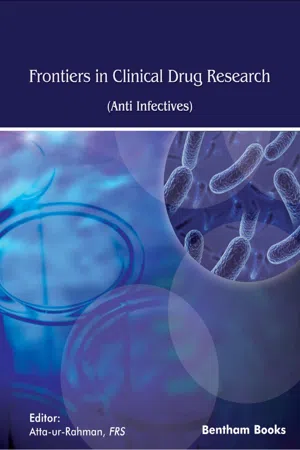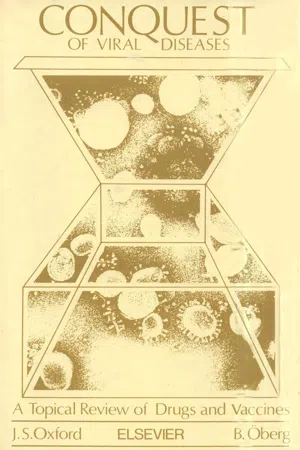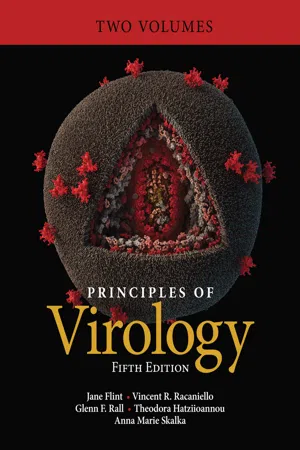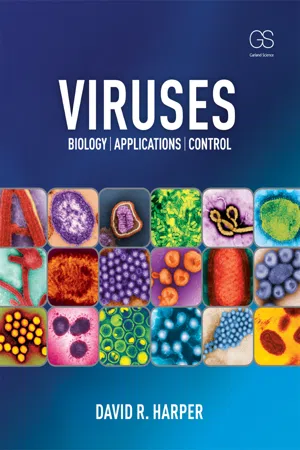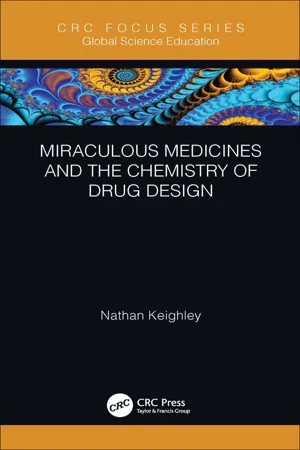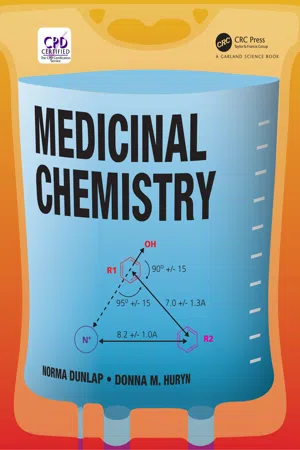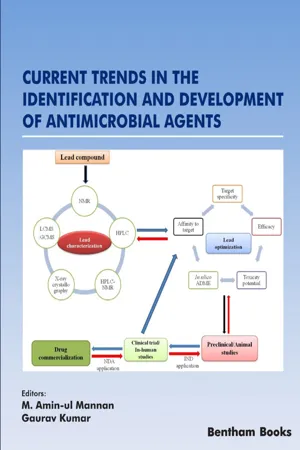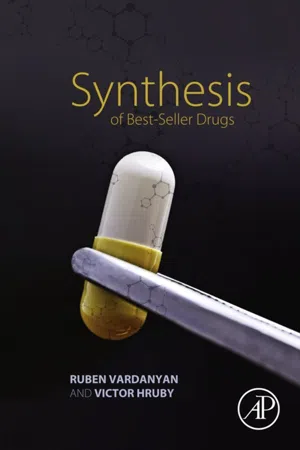Biological Sciences
Antivirals
Antivirals are a class of medications used to treat viral infections by inhibiting the replication of viruses or boosting the body's immune response to the infection. They can target specific viruses or have a broad-spectrum effect against multiple types of viruses. Antivirals are important in managing viral diseases such as influenza, HIV, herpes, and hepatitis.
Written by Perlego with AI-assistance
Related key terms
1 of 5
12 Key excerpts on "Antivirals"
- eBook - ePub
How Synthetic Drugs Work
Insights into Molecular Pharmacology of Classic and New Pharmaceuticals
- Imran Kazmi, Sanmoy Karmakar, Md Adil Shaharyar, Muhammad Afzal, Fahad A. Al-Abbasi(Authors)
- 2022(Publication Date)
- Academic Press(Publisher)
Chapter 20Insights into the mechanism of action of antiviral drugs
Reshma Kumari1 , Sandipan Jana1 , Susmita Patra2 , Pallab Kanti Haldar1 , Rudranil Bhowmik1 , Avishek Mandal1 , Kumar Anand1 , Hindol Mazumdar1 , Md. Adil Shaharyar1 and Sanmoy Karmakar1 ,1 Bioeuivalence Study Centre, Department of Pharmaceutical Technology, Jadavpur University, Kolkata, West Bengal, India,2 Department of Pharmaceutical Technology, Adamas University, Barasat, Kolkata, West Bengal, IndiaAbstract
Antivirals are the class of medications used to treat viral infections. Due to the rise in number and necessity for new antiviral drugs, this chapter focuses on information regarding viral pathophysiology, antiviral drugs, their mechanism of actions, and also new promising Antivirals that are undergoing studies and that may become fruitful.Introduction
Viruses are ultramicroscopic infectious parasites that have a genome (either RNA or DNA) or enzymes stored in a capsid (capsule made of protein). In some viruses, capsid is also covered with a lipid layer (envelope).1Viruses are obligate parasites because they require host cells to reproduce and complete their life cycle. These host cells may include mammalian or insect or plant or bacterial cells. Virus not only depends on nutrition but also uses metabolic machinery of the host cell for their growth. Therefore it is considered difficult to find antiviral drug that would selectively target virus without harming the infected host cells.2 –4Virus life cycle and pathogenesis
Viruses propagate using a host cell to produce its clones, as a means of reproduction for further generation. Life cycles of all viruses share a general pattern: - No longer available |Learn more
- (Author)
- 2014(Publication Date)
- Learning Press(Publisher)
________________________ WORLD TECHNOLOGIES ________________________ Chapter- 4 Antiviral and Antiretroviral Drug Antiviral Drug The guanosine analogue Aciclovir ________________________ WORLD TECHNOLOGIES ________________________ Guanosine Antiviral drugs are a class of medication used specifically for treating viral infections. Like antibiotics for bacteria, specific Antivirals are used for specific viruses. Unlike most antibiotics, antiviral drugs do not destroy their target pathogen; instead they inhibit their development. Antiviral drugs are one class of antimicrobials, a larger group which also includes anti-biotic, antifungal and antiparasitic drugs. They are relatively harmless to the host, and therefore can be used to treat infections. They should be distinguished from viricides, which are not medication but destroy virus particles outside the body. Most of the Antivirals now available are designed to help deal with HIV, herpes viruses (best known for causing cold sores and genital herpes, but actually causing a wide range of diseases), the hepatitis B and C viruses, which can cause liver cancer, and influenza A and B viruses. Researchers are working to extend the range of Antivirals to other families of pathogens. Designing safe and effective antiviral drugs is difficult, because viruses use the host's cells to replicate. This makes it difficult to find targets for the drug that would interfere with the virus without also harming the host organism's cells. The emergence of Antivirals is the product of a greatly expanded knowledge of the genetic and molecular function of organisms, allowing biomedical researchers to under-stand the structure and function of viruses, major advances in the techniques for finding new drugs, and the intense pressure placed on the medical profession to deal with the human immunodeficiency virus (HIV), the cause of the deadly acquired immu-nodeficiency syndrome (AIDS) pandemic. - Atta-ur-Rahman(Author)
- 2006(Publication Date)
- Bentham Science Publishers(Publisher)
Pharmacotherapy of Emerging Antiviral AgentsGaurav M Doshi,1 , *Hemen S Ved1,Ami P Thakkar1,Nirav Y. Bhatia1,Prachi M Pimple11 Department of Pharmacology, SVKM’s Dr. Bhanuben Nanavati College of Pharmacy, V. M. Road, Vile Parle (W), Mumbai, IndiaAbstract
Anti-infective agents have been one of the greatest accomplishments of modern medicine, which has led to a decrease in the number of deaths caused by various infectious diseases. The anti-infective agents are a broad family consisting of antimicrobials, antifungals, antimalarials, antiprotozoal, antituberculosis, and antiviral agents. Viral infections have caused millions of casualties worldwide, leading to the need for the development of effective antiviral agents. Although the replication mechanism differs significantly between the viruses, all viruses undergo steps like attachment, entry, genome replication, gene expression, and assembly for the release of the virions into the body of the host. Treatment with antiviral agents is essential for blocking the replication of the virus, and the currently available antiviral therapies are directed according to the disease. Furthermore, the treatment with antiviral agents aims to eradicate the viral pathogen from the host and prevent the clinical manifestation. Infectious diseases, such as human immunodeficiency virus (HIV), hepatitis B, and hepatitis C virus (HBV and HCV), and influenza, are of significant global concern. On the contrary, the outbreak of newer strains of influenza virus and Zika virus, Ebola virus, strains of coronavirus (CoV) like severe acute respiratory syndrome (SARS – CoV), Middle East respiratory syndrome (MERS – CoV) and novel Coronavirus (2019-nCoV) are life-threatening viral infections that exhibit major challenges to the humanity. As of date, multiple effective virostatics that target specific viral replication steps are approved for the treatment of viral infections. However, the use of such agents is restricted given the rapid emergence of antiviral resistance, which remains a major concern of current antiviral therapy. In this chapter, we summarize recent antiviral agents that show promising clinical benefits in various phases of clinical trials and also consider them as potential therapeutic agents in the future. Besides, we highlight and analyze the development of novel inhibitors targeting various stages of the viral life cycle that act by distinct mechanisms against current and emerging viral infections. Many antiviral drugs currently available are based on the concept of traditional chemotherapy. Nevertheless, new developments and advances in molecular biology have opened up possibilities to alternate treatment approaches. Clinical trials to evaluate gene silencing mediated by small interfering RNA (siRNA) and antisense RNAs expression against infection with a respiratory syncytial virus (RSV) have recently been initiated. Moreover, in–vitro- eBook - PDF
Perspectives in Medical Virology, vol. 1
Perspectives in Medical Virology, vol. 1
- Brian Evans(Author)
- 2003(Publication Date)
- Elsevier(Publisher)
93 CHAPTER 3 Antiviral drugs: general considerations 3.1. Background Since viruses, in contrast to bacteria, replicate inside cells and use part of the cellu- lar machinery for this replication, the development of selective antiviral drugs has been difficult and slow. However, the situation improved about two decades ago when the first virus-coded enzymes were characterized and when a few selective antiviral drugs such as idoxuridine, methisazone and amantadine were discovered. These compounds were found by serendipity but today the scientific situation has changed and a number of virus specific processes are used as targets for a more rational selection and design of antiviral drugs. Possibilities of inhibiting virus multiplication can be localized to discrete events in the virus replication, separate from normal cellular functions. These steps will be briefly discussed in this chapter. A more detailed discussion of the mechanism of action of different inhibitors will be found in later chapters and, for example, the compounds affecting herpesviruses are discussed at some length in Chapter 1 1. The use of interferon and immunostimulators as antiviral agents are briefly de- scribed in this chapter as well as aspects of the inhibition of myxo and paramyxovir- uses. Inhibitors of virus replication could either change a cellular function so that the virus can no longer replicate, or could interact with a viral function as indicated in Fig. 3.1. In the latter case a compound could act directly as an inhibitor of a viral enzyme (e.g. inhibition of herpesvirus DNA polymerase by foscarnet) or be activated by a viral enzyme (e.g. phosphorylation of acyclovir by a viral thymidine kinase) to form a compound which then affects virus replication and, in some cases, 94 INHIBITION - ACTIVATION ANTIVIRAL AGENT , I 1 I VIRAL jNJ Y E 1 ACTIVE ANTIVIRAL AGENT 1 I VIRAL PRODUCT INHIBITION OF VIRUS AND/OR CELL FUNCTIONS Fig. - eBook - ePub
- Erik Lycke, Erling Norrby(Authors)
- 2014(Publication Date)
- Butterworth-Heinemann(Publisher)
In spite of relatively extensive efforts to develop antiviral drugs, only a limited number of compounds which can be used in man have become available. The reason for this is the difficulty in finding substances which selectively influence the replication of virus without having toxic effects on cells. Another problem concerns the fact that cell damage caused by a virus infection is often very extensive already at the stage when the first symptoms appear. During recent years our knowledge about the molecular events in virus replication has increased markedly and it is therefore now possible to search more systematically for drugs which block virus-specific processes without damaging normal cellular functions. Interferon, which was discovered in 1956, was for a long time the only antiviral drug which fulfilled the criteria of efficient inhibition of virus replication and low toxicity. However, it has been possible recently to produce several other relatively non-toxic substances with a verified or a potential therapeutic effect on virus infections.The work with antiviral drugs has been concentrated on substances which may have an effect on herpes and influenza virus infections, even though hepatitis B virus and rhinovirus infections also have been considered as important targets for antiviral treatments. In this chapter the mechanisms of action of some antiviral drugs are described as well as some preclinical and clinical studies with these drugs. A separate part of the chapter is devoted to interferon.Theoretically one might consider blocking virus replication at either of the following stages; adsorption, penetration, uncoating, the synthesis of viral nucleic acids and proteins and the assembly and release of virus particles. It is primarily in connection with the viral nucleic acid synthesis, that viral enzymes different from cellular enzymes play a major role. The differences have been exploited to obtain a selective blocking of virus replication.Mechanisms of action of antiviral drugs
Antiviral drugs can roughly be divided into three classes depending upon their mechanisms of action:I Substances which selectively inhibit viral functions without any significant influence on the metabolism of uninfected cells. Example: phosphonoformic acid (Foscarnet). II Substances which in the infected cells are converted by a viral enzyme to compounds which inhibit virus replication. Examples: acycloguanosine (Acyclovir). III Substances which act by influencing the cell, thereby establishing an antiviral state. Examples: interferon, immunostimulators, ribavirin and possibly also amantadine. - eBook - ePub
- Jane Flint, Vincent R. Racaniello, Glenn F. Rall, Theodora Hatziioannou, Anna Marie Skalka(Authors)
- 2020(Publication Date)
- ASM Press(Publisher)
Fig. 8.1 ): it consists of approximately 90 antiviral drugs that have been approved to treat nine different human viral infectious diseases. This paucity reflects the many challenges that must be met in drug development. However, when available, Antivirals can have a major impact on human health. Because of their medical importance, most of our antiviral drugs are directed against infections with human immunodeficiency virus type 1, herpesviruses, and hepatitis viruses. In these cases, literally millions of lives have been saved by use of antiviral drugs.One major limitation in antiviral drug development is the requirement for a high degree of safety. This restriction can be difficult to surmount because virus reproduction depends on cellular functions: a compound that blocks a pathway that is critical for the virus can also have deleterious effects on the host cell. Another requirement is that antiviral compounds must be extremely potent at the site of infection: even modest reproduction in the presence of an inhibitor provides the opportunity for selection of resistant mutants. Achieving sufficient potency to block viral reproduction completely is remarkably challenging. Other limitations can be imposed by the difficulty in propagating some medically important viruses in the laboratory (e.g., hepatitis B virus and papillomaviruses) and the lack of small-animal models that faithfully reproduce infection in humans (such as measles and hepatitis C viruses). Lack of rapid diagnostic reagents has also hampered the development and marketing of antiviral drugs to treat many acute viral diseases, even when effective therapies are available. Many acute virus infections are of short duration, and by the time the patient feels ill, it is too late to impact clinical disease. Economic considerations also play a role: pharmaceutical companies mainly focus on viral diseases that can provide substantial profits.A Brief History of Antiviral Drug Discovery
The first large-scale effort to find antiviral compounds began in the early 1950s with a search for inhibitors of smallpox virus reproduction. At that time, virology was in its infancy and smallpox was a worldwide scourge. Drug companies expanded efforts in the 1960s and 1970s, spurred on by increased knowledge and understanding of the viral etiology of common diseases, as well as by remarkable progress in the discovery of antibiotics to treat bacterial infections. Companies launched massive screening programs to find chemicals with antiviral activities. These antiviral discovery programs comprisedblind screening - eBook - PDF
- G.J. Galasso, C.A.B. Boucher, D.A. Cooper, D.A. Katzenstein(Authors)
- 2002(Publication Date)
- Elsevier Science(Publisher)
CHAPTER 1 CLASSES OF ANTIVIRAL DRUGS MIREILLE VAN WESTREENEN and CHARLES A. B. BOUCHER Table of Contents Introduction . . . . . . . . . . . . . . . . . . . . . . . . . . . . . . . . . . . . . . . . . . . . . . . . . . . . . . . . . . . . . . . . . . 1 I. Inhibition of Viral Proteins ............................. . . . 3 Binding and Entry . . . . . . . . . . . . . . . . . . . . . . . . . . . . . . . . . . . . . . . . . . . . . . . . . . . . . . . . . . . 3 Replication . . . . . . . . . . . . . . . . . . . . . . . . . . . . . . . . . . . . . 4 Release .................................................................... 7 11. Inhibition of Virus Replication By Cellular Enzymes . . . . . . . Conclusion ........................................... References ............................... Introduction Being obligate intracellular parasites, viruses are dependent on the metabolic pathways of the host cell for their replication. So, virus and host cell are intimately connected and an effective antiviral agent must be able to distinguish virus related enzymes from host cell material itself. The search for antitumour agents generated a great deal of interest in DNA synthesis inhibitors. The first drugs capable of inhibiting viral DNA in vitro were described in the 50s, but real progress was not made until the 70s. In the last decades we have come to know more about the biochemistry of viral replication and this has led to a more rational approach to the search for antiviral agents. When reviewing the possibilities for antiviral chemotherapy, the best guideline is the viral replicative cycle, which can be divided in ten steps (Figure 1). First a virus binds to the cell surface of the host cell and penetrates the cell membrane and shed its protein coat (1-3 binding and entry). The genetic material of the virus uses the biochemical mechanisms of the host cell to replicate the genetic material of the virus (4-8 replication). - eBook - PDF
Viruses
Biology, Applications, and Control
- David Harper(Author)
- 2011(Publication Date)
- Garland Science(Publisher)
About the chapter opener image Rhinovirus (Courtesy of the Research Collaboratory for Structural Bioinformatics Protein Data Bank and David S. Goodsell, The Scripps Research Institute, USA.) INTRODUCTION Antiviral drugs have come a long way in the 50 years since their first discovery. The technology has moved from early drugs with marginal effects and significant toxicity to precisely designed inhibitors of specific viral functions. Similarly, the underlying science has moved from simple screening of potential compounds to exquisitely detailed understanding of viral targets. Currently there are over 40 licensed antiviral drugs from 11 broadly defined classes, targeting viruses from eight families. However, the classical challenges of antiviral drug development remain: most drugs affect only one or a few related viruses, toxic side effects remain for many current drugs, and the chance of failure for any drug candidate remains high. The development of resistance to a newly developed drug can be rapid. Understanding how these issues can be tackled underlies the field of antiviral drug development. CHAPTER 6 Antiviral Drugs 132 6.1 EARLY ANTIVIRAL DRUG DEVELOPMENT The first antiviral drugs were derived from the sulfonamide antibiotics in the early 1950s, when thiosemicarbazone compounds were found to be active against poxviruses. This raised the possibility of antiviral chemother-apy against smallpox ( Poxviridae ), which was still a major cause of human disease at that time. Further efforts identified methisazone, a synthetic thi-osemicarbazone, which appeared to be effective in preventing smallpox and in controlling complications of vaccination with the live vaccinia virus vaccine. With the thiosemicarbazones, the ratio between the toxic dose and the effective therapeutic dose (known as the therapeutic index ) was small and, in time, vaccination was to prove far more effective at bringing small-pox under control (see Chapter 5). - Nathan Keighley(Author)
- 2020(Publication Date)
- CRC Press(Publisher)
In developing countries, viruses still present a devastating and omnipotent threat. Originally, these outbreaks were contained in small communities, and, although fatal to many in a localised remote area, the risk of widespread epidemic was smaller. However, with larger populations and the convenience of air travel, rare diseases are much more easily spread around the world. Scientist fear a catastrophic scenario involving the possible evolution of a ‘super virus’ with a transmission mode and infection rate akin to influenza, but with a much higher mortality rate. There are viruses that spread rapidly with high incidences of fatality, but fortunately the latency period between infection and detection of symptoms is short, so the diseases can be contained. However, should a virus evolve that has a latency period that is longer, more people would likely become infected and this would cause widespread devastation.With contemplation of historical events, the containment and prevention of viral diseases spreading among populations is of crucial importance to ensuring safety in modern society. Instrumental in managing viral diseases are the medicines developed to combat the infections. Targeting viruses is very difficult, due to the considerable differences between their structure and that of cellular entities. In combatting bacterial infection, anti-bacterial agents could be found in nature and utilized through fermentation processes to produce antibiotics. Further modifications could be made to the structure to yield novel and effective semisynthetic drugs to combat resistance. Antiviral agents must be designed from scratch based on information from identified targets and this led to the development of rational drug design; a great advancement in medicine. Medicinal chemists now could not only incorporate natural products into designing new drugs, but design and synthesise completely unique chemical structures which interact with biological targets and offer a new line of defence against pathogens.In order to be able to identify targets against which drugs can be developed, knowledge of the structure and life cycle of viruses is paramount. A virus particle can simply be considered as a protein package that contains a type of nucleic acid with which it can infect host cells and hijack the host cell’s machinery to reproduce itself. Viruses contain one or more molecules of either RNA or DNA, but not both, thus are defined as either RNA viruses or DNA viruses. The RNA can be single-stranded (ssRNA) as is the case for most viruses, or double stranded, where the base sequence of the RNA that is the same as viral mRNA is called the (+) strand and its complementary partner is the (−) strand. Most DNA viruses contain the typical double stranded DNA, but single-stranded DNA is present in some viruses. There is great variation between viruses in the size of the nucleic acid, ranging from genomes coding for just three-to-four proteins to larger genomes that code for over one hundred proteins.- eBook - ePub
- Norma K Dunlap, Donna M Huryn(Authors)
- 2018(Publication Date)
- Garland Science(Publisher)
Antiviral and antifungal agents 11 LEARNING OBJECTIVES Describe the common points of intervention for antiviral therapy. Identify classes of drugs that target viral enzymes involved in nucleic acid replication. Understand the medicinal chemistry approaches taken to discover and develop antiviral protease inhibitors. Describe drugs that target viral attachment, uncoating, and budding. Explain the mechanism of action of antifungal agents. B oth viral and fungal infections lead to diseases and conditions that range from mild, such as the common cold or athlete’s foot, to deadly, such as AIDS or systemic fungal infections. Until the mid-1900s, there were no safe drugs to treat either type of infection. Historically, however, certain viral infections such as smallpox and polio have been prevented with vaccines, which, when administered, provoke an immune response so that antibodies are present in case of exposure. Vaccines have been in use since 1798, when Edward Jenner advocated the use of cowpox vaccine to protect against smallpox. Although they are effective against many viruses, for a variety of reasons, vaccines against certain viruses, as well as against fungal infections, have not yet been developed, despite the medical need. For the instances when vaccines are not available (or not effective), there are a number of approved drugs to treat viral diseases, but far fewer drugs are available to treat fungal infections. These numbers are small, however, when compared to drugs that treat bacterial infections, which are the subject of Chapter 12. There are several reasons for this disparity, but a primary explanation is related to the difference between bacterial, viral, and fungal drug targets and human homologs. Since viruses rely, to varying degrees, on human proteins to replicate, there are only a few viral- specific targets that drugs can affect. The reason for the lack of drugs for fungal infections is different. Fungi are eukaryotic organisms, as are animals - M. Amin-ul Mannan, Gaurav Kumar, M. Amin-ul Mannan, Gaurav Kumar(Authors)
- 2008(Publication Date)
- Bentham Science Publishers(Publisher)
Salvia plebeian R. Br [19 ] Isoflavone Genistein Herpes B Virus (HBV) Blocks the late phase event in the life cycle of the Herpes B virus. Mainly inhibits the phosphorylation of glycoproteins Genista tinctoria [20 ] Alkaloid Dendrobine Influenza A virus Restraining the viral replication Dendrobium nobile [21 ] Triterpenoid 3, 4- secodammarane and Dammarenolic acid HIV Inhibit the cell cycle proliferation Aglaia sp. [22 ] Lignin Honokiol Dengue virus serotype-2 (DENV-2) Inhibit the synthesis of dsRNA and nonstructural proteins Genus Magnolia [23 ] Glycoprotein Apolactoferrin (a synthetic form of lactoferrin) and lactoferrin SARS-CoV-2 Interacts with heparan sulfate proteoglycans and angiotensin-converting Enzyme-2 (ACE-2) receptors of human Bovine milk and other body fluids [24 ]There have been clinical trials involving natural products against SARS-CoV-2. Further, this segment of antiviral drug therapy needed wide exploration along with methodical isolation of the active ingredients. The specific mode of action, in particular for any isolated active ingredients, i.e., used for different therapeutic categories, must be well approved by the drug regulatory authorities.Chemical Entities and Different Types of Formulations
Chemically antiviral drugs are small entities that are used in widespread infectious diseases. A specific antiviral drug target can be designed based on any targeted receptor of the host cells or the enzymes needed for viral replication. Here we elucidated the classification of the antiviral drugs in detail:Viral DNA Synthesis Inhibitors like Acyclovir, Valacyclovir, Maribavir and Letermovir
Acyclovir is an acyclic analogue of deoxiguanosine and Valacyclovir is an L-valyl ester prodrug [25 ]. Maribavir is a novel class of Benzimidazole riboside [26 ], whereas, Letermovir is an acetic acid derivative [27 ]. Acyclovir is very much effective against Herpes Simplex virus (HSV-1 and HSV-2) strains [25 ], Varicella-Zoster Virus (VZV) [28 ] and Epstein - Barr virus (EBV) [25 ]. Valacyclovir showed its effectiveness by eliminating high loads of herpes viruses in deep periodontal pockets and inflamed gingiva [29 ]. In contrast to Acyclovir, we find Maribavir [26 ] and Letermovir [27 ] are active against Cytomegalovirus (CMV). Exceptionally upon the other commonly used anti-CMV drugs like Ganciclovir, Foscarnet and Cidofovir, we find that Maribavir showed potent in-vitro activity against the resistant CMV strains within an acceptable therapeutic index of the drug [26 ]. These drugs show their action by the inhibition of the viral DNA polymerase. Notable exceptions were only seen in the cases of Maribavir and Letermovir, which inhibits the protein kinase UL97 and DNA terminase complexes respectively [26 , 27- eBook - ePub
- Ruben Vardanyan, Victor Hruby(Authors)
- 2016(Publication Date)
- Academic Press(Publisher)
34.2. Indirect virus-targeting Antivirals
While the Antivirals currently in use exclusively target viral factors, several approaches now focus on cellular factors or pathways that indirectly interact with virus replication [305 -307] .Among them are inhibitors of intracellular signaling cascades that are essential for virus replication.Replication and transcription complex blockers block the formation of the viral replication and transcription complex, responsible for the production of the viral genome or other nucleic acids and ribonucleoprotein complex inhibitors which triggers the aggregation of and inhibits the nuclear accumulation of virally encoded nucleoprotein thereby inhibiting the replication of virus.Among them a new compound – nucleozin (34.2.1 ) which inhibits the replication of various influenza A virus strains [308] (Fig. 34.15 .).Fig. 34.15 Structure of nucleozin.Passage contains an image
References
1. De Clercq E. Antiviral drugs in current clinical use. J. Clin. Virol. 2004;30(2):115–133.2. De Clercq E. Antiviral drug discovery and development: where chemistry meets with biomedicine. Antiviral Res. 2005;67(2):56–75.3. Balfour Jr. H.H. Antiviral drugs. N. Engl. J. Med. 1999;340(16):1255–1268.4. Bonhoeffer S, May R.M, Shaw G.M, Nowak M.A. Virus dynamics and drug therapy. Proc. Natl. Acad. Sci. U. S. A. 1997;94(13):6971–6976.5. De Clercq E. Antiviral agents active against influenza A viruses. Nat. Rev. Drug Discovery. 2006;5(12):1015–1025.6. Boltz D.A, Aldridge Jr. J.R, Webster R.G, Govorkova E.A. Drugs in development for influenza. Drugs. 2010;70(11):1349–1362.7. Biron K.K. Antiviral drugs for cytomegalovirus diseases. Antiviral Res. 2006;71(2-3):154–163.8. Coen D.M, Schaffer P.A. Antiherpesvirus drugs: a promising spectrum of new drugs and drug targets. Nat. Rev. Drug Discovery
